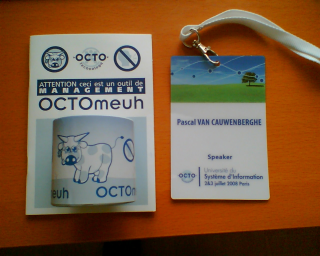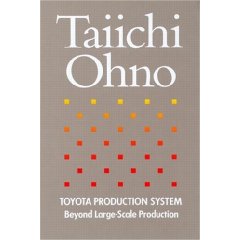Université du SI day 1: Philosophy
We travel from quiet Montparnasse to busy Champs Elysées in time for the Université du SI conference opening at 8 AM. We register, grab some coffee and pastries and have a chat with our hosts from OCTO. François Hisquin kicks off the conference and introduces Michel Serres, philosopher and member of the Académie Française.
Serres talks about changes in the relation between ‘hard’ vs ‘soft’ (medium vs message) and actual vs virtual. He reviews several fundamental changes, like the invention of language, writing and printing, and believes that we are witnessing a new fundamental change thanks to IT. For example, distance is becoming less and less important as everything becomes virtual. According to Serres humanity loses something with each revolution of the evolution cycle. He states (with apparent relish) that our ability to remember things is being exchanged for access to much larger amounts of information than we could ever hope to remember in a lifetime.
It might seem strange to kick off an IT conference with a philosopher’s speech, but the audience really liked the presentation. I found it a bit high level and abstract. What was the message we could take away from this talk? Physical distance is still real, otherwise why would we have traveled to Paris to attend the conference? I remain puzzled by Serres’ talk.
Outsourcing and being Googley
Next up, we attend a talk by Guillaume Bodet on the dangers and methods of outsourcing. It is a good overview of the subject with different methods to align the goals of customer and service provider.
The food and drinks are excellent but the lunch is a little crowded and inefficient. What is the goal? Where is the bottleneck? How can we exploit it? This isn’t the first lunch that is served at this conference center. I would have thought that they would have improved the process by now. What is the constraint that holds the conference center back on improving? That’s the problem with the Theory of Constraints: once you’ve encountered it, you see the world differently; you can’t stop applying the “5 focusing steps”.
In the afternoon we attend a session on innovation and how Google’s company culture encourages innovation. The presentation starts with a “Zen” style overview of innovation, followed by the principles of Google’s innovation culture. Due to lack of time, the second part is cut short. To make this presentation perfect I would spend less time on the “what is innovation?” part and focus on explaining what Google does, why they do it and how we can apply the lessons to our own companies.
A l’aide! Mon processus m’étrangle!
Then Portia and I run the “Bottleneck Game” session as part of the Agile training track. This was the last session on an intensive day for the participants, but they participated fully in the fun simulation. The chocolates and sweets helped to motivate them and to keep their energy up.
We run the session as we had discussed at the previous day’s retrospective, guided by Portia’s beautiful map of the session. We have a little less time than expected because the previous session ran over, but we still manage to run the three rounds of the game. The team does really well: with results of 2, 4 and 8 pairs of boats and hats they do better than any team that week. They end up quadrupling their output using simple Agile and Lean techniques. None of the techniques used cost much money, time or effort. How much more value could you produce by making a few simple changes?
Concentrate on value, not waste!
From discussions between the sessions and from the session topics we gather that there is a growing interest in applying Lean and Theory of Constraints to IT. The Université provided us with an opportunity to share experiences between the IT and manufacturing worlds. There is a genuine interest to really improve the way we work. But there is one thing that bothers Portia and me: there is a lot of talk about (eliminating) waste; very little about (increasing) value.
Throughput and Constraint Accounting tell us to improve Throughput (value added) first, reduce Investment/Inventory second and only try to reduce Operating Expense (fixed costs) as a last resort. Is there a conflict between Theory of Constraints (increase value first) and Lean (decrease waste/cost first)?
 We don’t think so; we think that the message of Lean has been misunderstood. What does Taiichi Ohno, founder of Lean, say in “Toyota Production System. Beyond Large-scale Production“?
We don’t think so; we think that the message of Lean has been misunderstood. What does Taiichi Ohno, founder of Lean, say in “Toyota Production System. Beyond Large-scale Production“?
“All we are doing is looking at the time line from the moment the customer gives us and order to the point when we collect the cash. And we are reducing that time line by removing the non-value-added wastes.” (Foreword, p. ix).
We read this as: increasing value for the customer, increasing throughput for the company is the goal. One of the ways to do that is to remove non-value-added wastes. Why? There is a limit to how much you can decrease costs; the amount of value you can add is essentially infinite, only limited by your imagination.
More about that later, I’m sure, when Eli Goldratt (!) opens the second day of the conference
Closing day 1
Bjarne Stroustrup, author of C++, closes the day with an overview of the history of the language. Having programmed in C++ for 10 years, there was little new information, but the look behind the screens of development and standardisation of a language is interesting. Bjarne comes over as a humble, but passionate ‘father’ of the language. Could he have done things differently; could the result have been better? Yes, he says so himself. It’s easy to do better with the 20/20 vision of hindsight. C++ is a success and still has its place after all those years.
The first day closes with some drinks and more talk about Lean, Agile and Theory of Constraints. Portia and I go to dinner with a nice bunch of agilists, where we have more good food and drink, jokes and discussion. Portia discovers that one of her blog readers imagined her as a little old lady, sort of an agile Miss Marple 🙂
Day 2 of the Université features another run of the Bottleneck Game and keynotes by two of my heroes: Eli Goldratt (!) and Neil Armstrong (!!!).